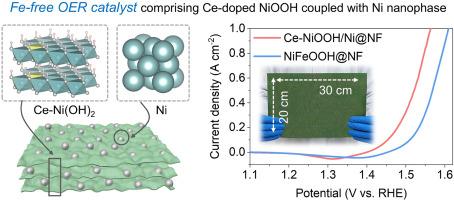掺杂铈的NiOOH与Ni纳米晶耦合,在无铁催化剂上实现高电流密度水氧化
IF 8.3
2区 工程技术
Q1 CHEMISTRY, PHYSICAL
引用次数: 0
摘要
由于其固有的低活性和较差的析氧反应电子转移特性,开发无铁过渡金属基催化剂来克服离子浸出降解仍然是一个关键的挑战。本文通过一步电沉积法合成了一种将非晶掺杂铈的NiOOH与Ni纳米晶体集成在一起的无铁催化材料,实现了600 cm2以上均匀阳极的可扩展制造。在1 M KOH条件下,过电位分别为190 mV和332 mV,达到10和1000 mA cm−2。此外,在1000 mA cm−2下连续操作1000 h后,其活性保持率为98.7%。XPS, XANES,原位拉曼光谱和密度泛函理论(DFT)计算表明,Ni纳米晶体显著增强了NiOOH中的界面和体电荷输运,而Ce掺杂显著促进了预氧化过程和OER动力学。这项工作为设计具有高碱性OER性能的无铁催化材料提供了见解。本文章由计算机程序翻译,如有差异,请以英文原文为准。

Ce-doped NiOOH coupled with Ni nanocrystals endowing high-current-density water oxidation on iron-free catalysts
Developing iron-free transition-metal based catalysts to overcome ion-leaching degradation is still a critical challenge due to their inherent low activity and poor electron transfer characteristics for oxygen evolution reaction (OER). Herein, an iron-free catalytic material integrating amorphous Ce-doped NiOOH with Ni nanocrystals was synthesized via a one-step electrodeposition method, achieving scalable fabrication of a uniform anode over 600 cm2. It shows remarkably low overpotentials of 190 mV and 332 mV to achieve 10 and 1000 mA cm−2 in 1 M KOH, respectively. Moreover, it maintains 98.7 % activity retention after 1000 h of continuous operation at 1000 mA cm−2. XPS, XANES, in-situ Raman spectroscopy and density functional theory (DFT) calculations demonstrate that Ni nanocrystals significantly enhance the interfacial and bulk charge transport in NiOOH, while Ce doping substantially promotes both the pre-oxidation process and OER kinetics. This work provides insights for designing iron-free catalytic materials with high alkaline OER performance.
求助全文
通过发布文献求助,成功后即可免费获取论文全文。
去求助
来源期刊

International Journal of Hydrogen Energy
工程技术-环境科学
CiteScore
13.50
自引率
25.00%
发文量
3502
审稿时长
60 days
期刊介绍:
The objective of the International Journal of Hydrogen Energy is to facilitate the exchange of new ideas, technological advancements, and research findings in the field of Hydrogen Energy among scientists and engineers worldwide. This journal showcases original research, both analytical and experimental, covering various aspects of Hydrogen Energy. These include production, storage, transmission, utilization, enabling technologies, environmental impact, economic considerations, and global perspectives on hydrogen and its carriers such as NH3, CH4, alcohols, etc.
The utilization aspect encompasses various methods such as thermochemical (combustion), photochemical, electrochemical (fuel cells), and nuclear conversion of hydrogen, hydrogen isotopes, and hydrogen carriers into thermal, mechanical, and electrical energies. The applications of these energies can be found in transportation (including aerospace), industrial, commercial, and residential sectors.
 求助内容:
求助内容: 应助结果提醒方式:
应助结果提醒方式:


